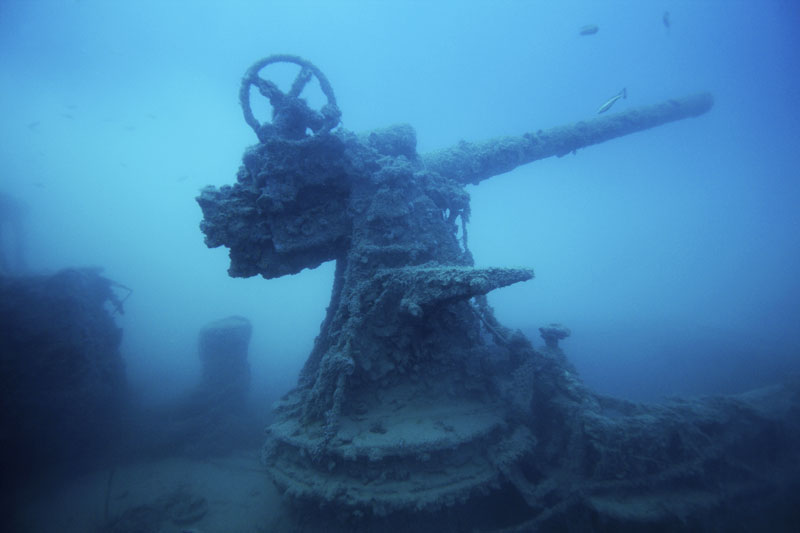Following multi-stakeholder coordination, revised regulations were published in the Federal Register Aug. 31 to implement the Sunken Military Craft Act (SMCA), permitting requirements for conducting intrusive activity on sunken military craft under the jurisdiction of the Department of the Navy (DON).
The regulations establish a permitting process for those interested in pursuing intrusive activities on DON sunken and terrestrial military craft for archaeological, historical, or educational purposes as specified in the act. The rule also identifies guidelines for inclusion of foreign or other Department of Defense sunken military craft under DON’s permitting program, and establishes the process by which enforcement provisions of the SMCA will be implemented.
The new regulations, while published today, will officially go into effect six months from now on March 1, 2016. During the interim the existing permitting program will continue to apply. The Naval History and Heritage Command, in concert with other government agencies, will use the interim to develop and share information about the new program and process.
In so doing, the permitting process for such activity on terrestrial military craft under the jurisdiction of the Department of the Navy is also being aligned into the single permitting regime, in the interest of consistency and simplicity.
The SMCA, enacted in 2004, codified customary international law in asserting that right, title and interest in and to any U.S. government sunken military craft remains with the U.S. in perpetuity, unless expressly divested. These craft are not to be disturbed, removed, or injured, and violators may face enforcement action for doing so without authorization.
The Sunken Military Craft Act itself remains unchanged. The permitting processes being established do not amend or change the SMCA, or in any way expand the stated prohibitions of the act. Activities such as fishing, snorkeling and diving which are not intended to disturb, remove, or injure any portion of a sunken military craft are still allowed without the need for a permit.
“The Department of the Navy’s sunken ship and aircraft wrecks represent a collection of more than 17,000 non-renewable cultural resources distributed world-wide,” said Sam Cox, Curator of the Navy and Director of the Naval History and Heritage Command, the organization charged by the Navy with carrying out its responsibilities under the SMCA.
“These wreck sites often serve as war graves, safeguard state secrets, may carry environmental or public safety hazards such as oil and ordnance, and hold historical value. That’s why we take seriously our responsibility to protect them from disturbance. I am determined to honor this nation’s obligation to its fallen service members to protect the sanctity of those wrecks constituting the last resting place of American Sailors.”
In accordance with the SMCA, the Secretary of the Navy is authorized to establish a permitting program allowing otherwise prohibited activities directed at sunken military craft for archaeological, historical, or educational purposes. The DON has elected to establish such a permitting process through the revision to existing regulations (32 CFR 767). The new regulations, which can be read in full here (https://federalregister.gov/a/2015-20795), allow for controlled access to persons who are presently prohibited by the SMCA from disturbing, removing, or injuring DON sunken military craft, or their associated contents, and also provide similar processes pertaining to terrestrial military craft.
While unauthorized disturbance of sunken military craft will continue to be prohibited, actions of the U.S. government, or those acting at its direction, including commercial salvage entities under contract with the U.S., will continue to be allowed. The commercial salvage industry may therefore continue to operate through federal contracts and in coordination with the U.S. Government irrespective of the promulgation of the proposed regulations.
Similarly, recreational divers or commercial and sport fishermen may continue to operate over and around DON sunken military craft without requiring a permit as long as they do not intentionally or negligently disturb, remove, or injure them and their contents.
The revision to the current regulations was issued after a federal agency comment phase coordinated by the Office of Management and Budget ultimately led to the publication of a Proposed Rule in January 2014, which itself initiated a 60-day public comment period. The DON, after affording due consideration to all public comments and federal agency stakeholders, proceeded to revise the Proposed Rule and with today’s publication issued the Final Rule that will take effect on March 1, 2016.
A continually expanding resource for information on the implementing regulations, associated inter-agency agreements, outreach materials, and ultimately the guidelines for the revised application process, may be found on the web site of the Naval History and Heritage Command at:
http://www.history.navy.mil/research/underwater-archaeology/policy-and-resource-management.html
The Naval History and Heritage Command, located at the Washington Navy Yard, is responsible for the preservation, analysis, and dissemination of U.S. naval history and heritage. It provides the knowledge foundation for the Navy by maintaining historically relevant resources and products that reflect the Navy’s unique and enduring contributions throughout our nation’s history, and supports the Fleet by assisting with and delivering professional research, analysis, and interpretive services. NHHC is composed of many activities including the Navy Department Library, the Navy Operational Archives, the Navy art and artifact collections, underwater archeology, Navy histories, nine museums, USS Constitution repair facility and the historic ship Nautilus.
From Naval History and Heritage Command

